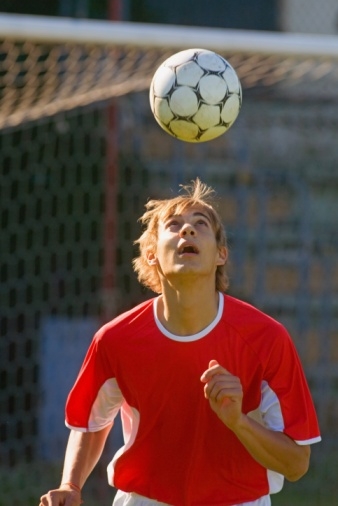Parents who believe that their kids are getting enough physical exercise just from playing organized sports may be in for a surprise.
A new study1 finds that, though participation in youth sports contributes to overall physical activity, less than one fourth of youth soccer, baseball and softball players studied obtained the sixty minutes a day of moderate to vigorous physical exercise (MVPA) during sports practices that U.S. guidelines recommend.2 
The study concluded that "youth sports practices are making a less-than-optimal contribution to the public health goals of increasing physical activity and preventing childhood obesity."
Exercise deficit found
Researchers from San Diego State University monitored 200 kids ages 7 to 14 during soccer, baseball and softball practices using accelerometers to track their activity levels. They found a lot less actual moving around during practices than some parents might have expected:
- Only 24 percent of 7- to 14-year old soccer, baseball and softball players got the sixty minutes of MVPA the government recommends during practices;
- Fewer than 10 percent of 11- to 14-year-olds and fewer than 2 percent of girl softball players reached the 60 minute physical exercise mark (compared to 32% of the boys);
- Soccer players spent about 17 more minutes per practice in vigorous physical activity than baseball/softball players. Because vigorous-intensity physical activity is more strongly related to youth body composition than moderate intensity activities, researchers concluded that playing soccer is more likely to contribute to health benefits generally, and obesity prevention specifically, than playing baseball/softball.
- During soccer practices, participants engaged in 55 minutes of MVPA compared to 41 minutes for baseball and softball practices;
- Girls got eleven minutes less MVPA than boys during sports practices. As noted in an editorial accompanying the study, girls, as reported by the Women's Sport Foundation, enter sports at a later age than boys; the study's findings that girls have lower physical activity levels than boys "highlights the need to examine physical activity levels in sports practices separately for boys and girls";
- Consistent age differences were found, with 11- to 14-year-old players obtaining 7 minutes fewer of MVPA per practice than 7- to 10-year olds, with no difference by sport. Researchers found this finding "unfortunate because the decline in total physical activity is steepest in the teenage years, and decreases in activity during sports practice may contribute to this decline."
On average, players were inactive for 30 minutes during each practice, which ranged in length from 40 to 130 minutes for soccer and 35 to 217 minutes for baseball or softball. The findings were consistent with a previous study based on direct observation finding that 43% of youth sports practice was spent being inactive.
"There clearly are opportunities to increase physical activity in youth sports," wrote Desiree Leek of San Diego State University and the University of California, and one of the study's co-authors. But "it appears that youth sports practices are making a less-than-optimal contribution to the public health goals of increasing physical activity and preventing childhood obesity."
The study, "Physical Activity During Youth Sports Practices," will be published in the April 2011 edition of the journal Archives of Pediatrics and Adolescent Medicine.
Recommendations
The researchers offered several recommendations on ways to increase physical activity during practices, including:
- Emphasizing participation over competition;
- Sponsoring teams for all skill levels across all ages;
- Ensuring access by lower-income youth with sliding scales for fees;
- Increasing practice frequency;
- Extending short seasons;
- Using pedometers or accelerometers to monitor physical activity periodically during practices;
- Providing coaches with strategies to increase physical activity; and
- Supporting youth and parents in obtaining adequate physical activity on non-practice days.
Parental disconnect
The study findings reveal a disconnect between the amount of physical exercise parents think their children are getting from organized sports and the amount they are actually exercising. Active Kids Canada, for instance, found that only 12 percent of Canadian youth were meeting that country's 90 minute guideline, even though three-quarters were participating in organized sports. Yet 88 percent of Ontario parents in another survey believed that their school-age children were "active."'
Take-away for parents and coaches
In an editorial accompanying the study, Russell Pate and Dr. Jennifer O'Neil of the Department of Exercise Science at the University of South Carolina said the study showed the "need to learn ways in which the doses of physical activity provided during youth sports and activity programs can be most effectively increased by modifying the manner in which the practices and contests are conducted ... [such as] by changes in instructional practices that produce greater emphasis on keeping youth active while they learn individual skills and team strategies."
Recognizing that many youth sports programs are run by volunteer coaches with little or no formal coaching training, they conceded that finding practical ways for these adult leaders to increase physical activity levels would pose a "special challenge."
Which was not to say, they said, that parents should in any way be discouraged from involving children in well-organized and properly supervised sports. But, in doing so, they said, parents need to know that:
- not all sports programs are created equal when it comes to providing MVPA (soccer provides a lot more than baseball/softball, for example)
- they shouldn't assume that because their kids play on a soccer or hockey team that they are getting enough exercise on a daily basis; and
- while youth sports programs can be an important source of physical activity for youth, most young people will not be able to meet current physical activity guidelines just through organized sports programs, and they therefore need to look for other ways for their kids to get 60 minutes of MVPA per day, such as through:
- School physical education (PE);
- Unstructured, informal physical activity in home or neighborhood settings (e.g. pick up games and sports)(a study measuring physical activity in after-school programs found that youth were significantly more active during free play than structured activity sessions);
- Biking or walking to and from school where possible; and
- Other activities involving physical
exercise, such as dance classes (e.g. ballet, jazz, contemporary, tap) and outdoor activity programs (e.g. rock climbing, cycling, canoeing, kayaking).

The bottom line for parents: "Organized sports needs to be an add-on, not a replacement for other activity," advises Mark Tremblay, chief scientific officer for Active Kids Canada.3
Participation by the numbers
- 44 million American youth participate annually in organized sports programs4
- More than 7 million students play high school sports5
- Nearly 60% of US high school students report engaging in sports programs.6
Sources:
1. Leek D, Carlson J, Cain K, Henrichon S, Rosenberg D, Patrick K, Sallis J. "Physical Activity During Youth Sports Practices," Archives of Pediatrics and Adolescent Medicine (April 2011)(published online December 6, 2010).
2. Physical activity guidelines for Americans. US Department of Health and Human Services (http://www.health.gov/paguidelines/guidelines/chapter3.aspx)(accessed December 8, 2010).
3. "Few kids get enough exercise by playing sports, study finds; Only 25 per cent get sufficient daily activity during team practices, researchers say." Toronto Star (December 7, 2010); Living Section, page E8.
4. National Council of Youth Sports. "Report on Trends and Participation in Organized Youth Sports, Stuart, FL; National Council of Youth Sports; 2008.
5. Fellmeth L. "High school sports participation tops 7.6 million, sets record. National Federation of State High School Associations. Website: http://www.nfhs.org/content.aspx?id=4208. Published September 8, 2010. Accessed December 8, 2010.
4. Eaton DK, Kann L, Kinchen S, et al. Centers for Disease Control and Prevention (CDC). "Youth risk behavior surveillance - United States, 2009. MMWR Surveill Summ, 2010; 59(5); 1-142.
Posted December 8, 2010








